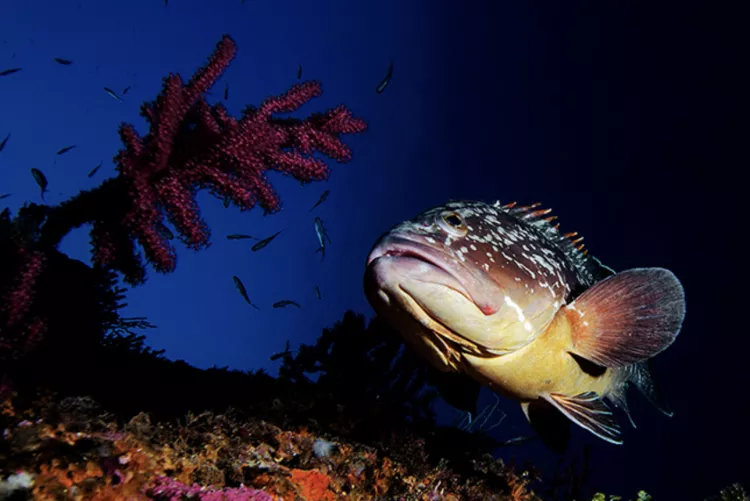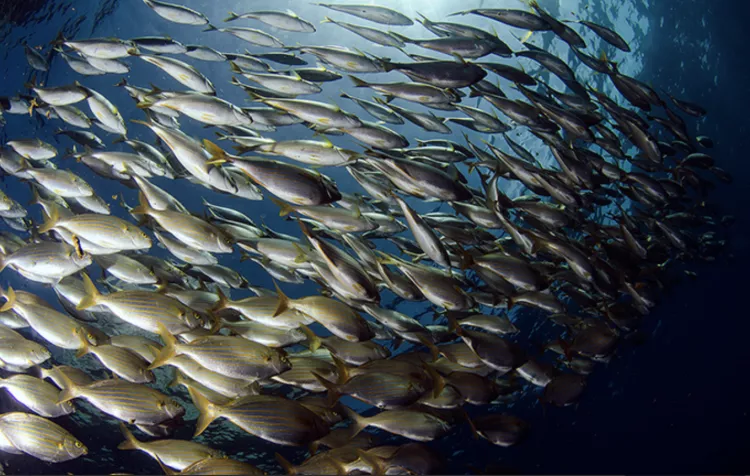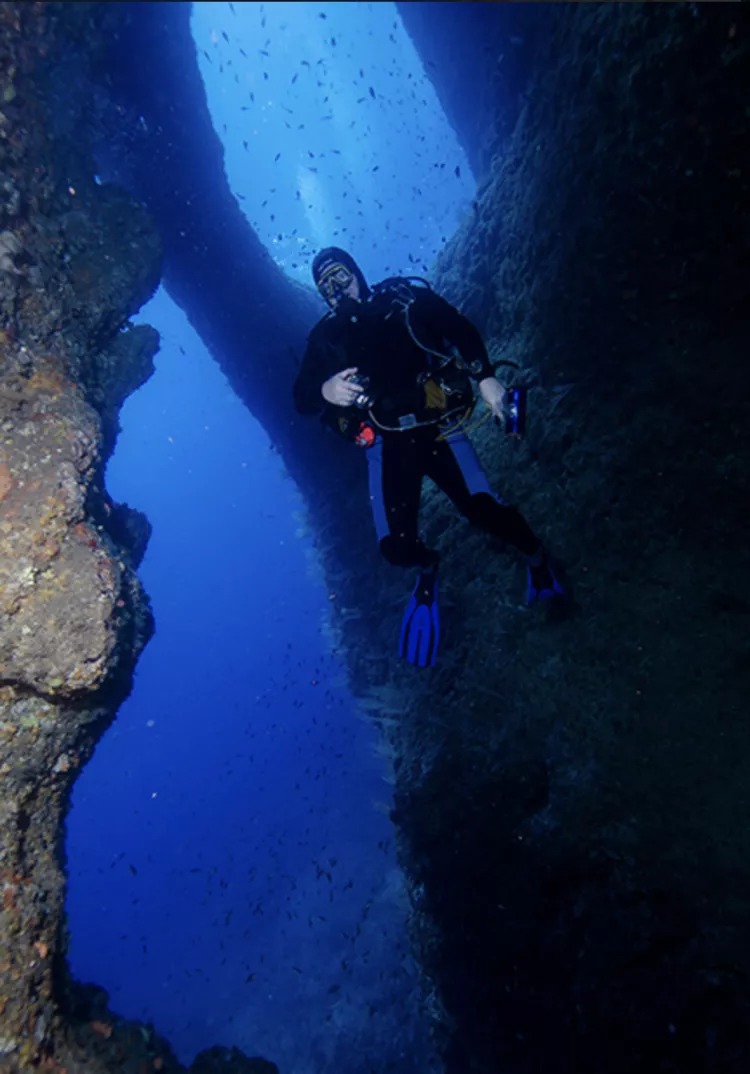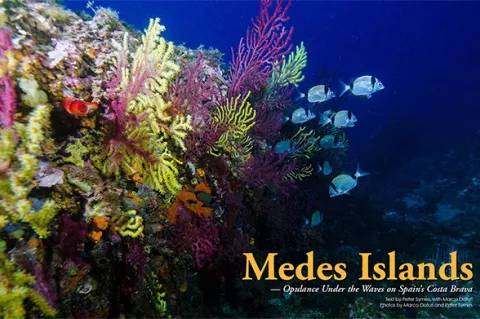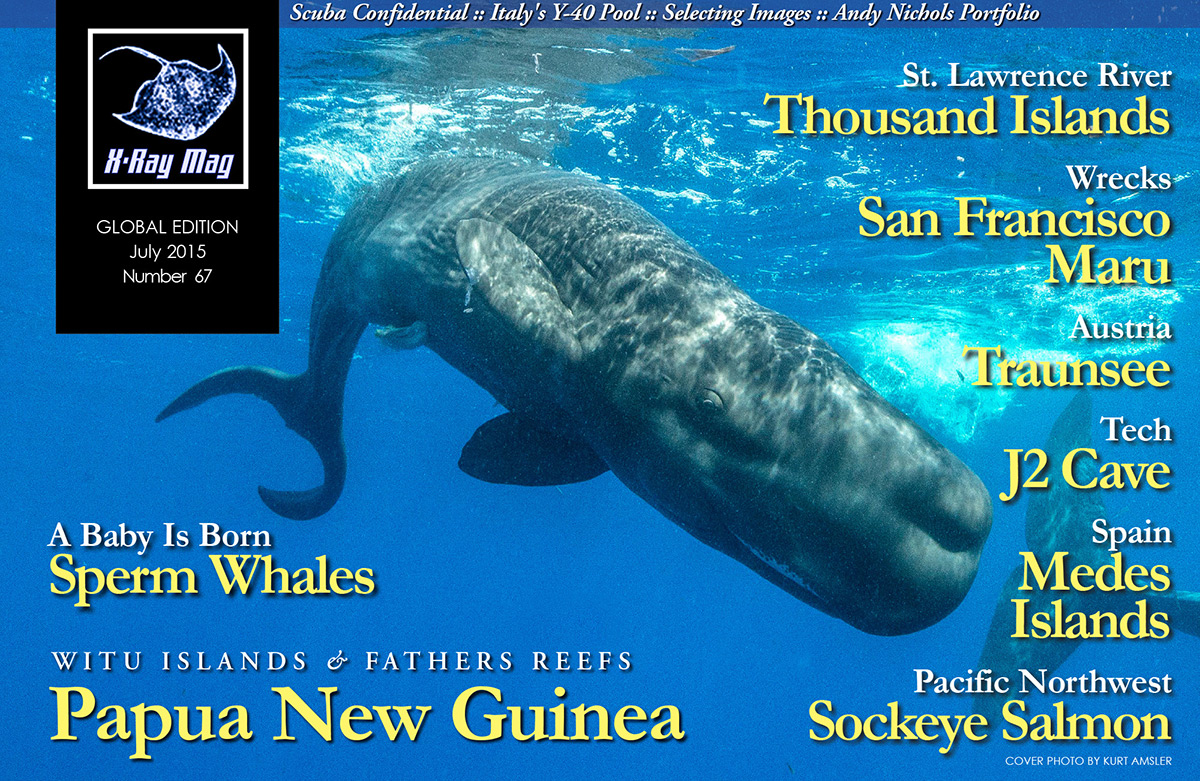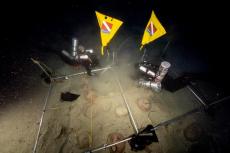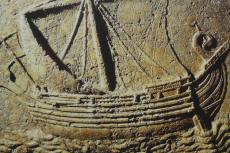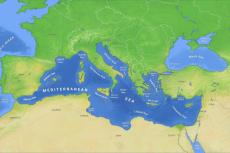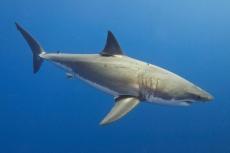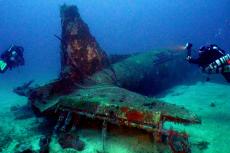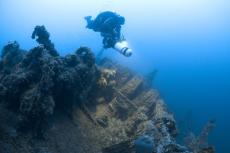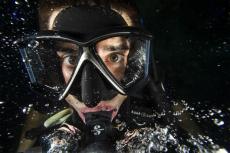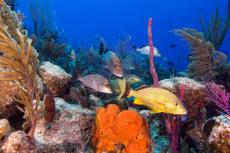At a glance, the Medes Islands doesn’t look like much—some 50 odd acres of craggy outcrops sitting close to shore, just opposite the small fishing village and resort town of L’Estartit, along the Spanish coast of Costa Brava. Little, if anything, gives away the fact that it is a marine national park boasting some of the most renowned diving in the Mediterranean.
Contributed by
It is commonly heard among European divers that they only care about venturing to the tropics because they believe there is so little to see in the Mediterranen. That is certainly not the case with the Medas Islands, which are covered by lush forests of colourful coral in which lots of other life has taken up refuge and there are schools of fish patrolling the steep coastline.
The islands were declared a protected area and marine reserve by the regional government in 1983 and are now one of the most important marine reserves in the Western Mediterranean. It is actually an archipelago made up of seven islands and several islets. Meda Gran is the biggest and only sizeable island that dominates the group; the rest are merely rocky outcrops and pinnacles sticking out of the sea.
L’Estartit and the Medes Islands are located just an hour’s drive south of the border to France and a couple of hours’ drive north of Barcelona, the capital of Catalonia—a semi-autonomous region in northeastern Spain and second largest city in the country, making it easy to get to even on a long-haul flight. Despite having grown into a popular resort town, L’Estartit has maintained much of its fishing village characteristics being built around the little port. The bigger hotels are mainly on the outskirts and so are several camping sites, but the old center is still made up of smaller buildings and narrow streets with lots of small shops, cafés and restaurants. There are several dive operators in town, so this is also where their diveboats are moored. From the port, it is only a short trip to the islands, which sit only a little over 1km from shore. It is such a short ride that one may just as well get kitted up before departure.
Diving
Soon enough, I found myself taking a giant stride off the diveboat and bobbing around to get my bearings straight. I took note that I was facing south, with Meda Gran on my left, so following the sun would set me on a course, parallel and close to the island.
On this day, the visibility was so-so, but I could make out some pinnacles in the haze just below me. I vented my vest and slowly started to sink towards the bottom. The colors were striking. The corals on the pinnacle below me were different hues of bright yellow, red and purple like a colorful bouquet.
As photographers do, I spent a few moments getting myself in order, tightening and adjusting straps, correcting my strobe arms and checking one more time that the camera was set correctly and prepared for whatever may suddenly turn up round the next corner. And so I set off, slowly descending along the pinnacle, keeping a close eye out for interesting sea life.
There was absolutely no need to hurry, as the interesting spot could be right where you were dropped off and not necessarily around the corner. Besides, going slow helped me settle down and get into a creative zone. I reached 25m and leveled off in order to conserve some air and non-deco time. Down here, the water was a bit cooler, so a wetsuit was definitely required. Residing in Scandinavia, I consider the waters of the Mediterranean comfortably warm, but those who predominantly dive the tropics may beg to differ. In any case, it is recommended that divers use a slightly thicker suit—5mm rather than 3mm—and you should be all set.
Above me, I saw a school of sea bream (Sarpa salpa)—recognizable by the golden stripes that run down the length of their bodies—congregating and moving slowly, like wannabe barracudas. Sea bream is quite a common species in the Mediterranean where it can be found down to depths of 70m.
It was only much later I learned that this fish was consumed as a recreational drug when the Ancient Roman Empire existed. The fish itself is apparently not psychoactive, but it may be rendered hallucinogenic when it ingests certain phytoplankton. I bet you didn’t know that.
I swam slowly forward, moving slowly across a ledge. There were fans of red coral all the way around it—in the shape of small leafless bushes that grow up to a meter in height—and interspersed between these and affixed to the rocky surface were colorful patches of sponges. It was like diving in a garden and I couldn’t help surrendering to the Zen moment.
Then, out of the corner of my eye, I noticed an almost imperceptible movement—an octopus was contorting itself into a crevice while taking on both the colors and the textures of the surroundings, its skin transforming into folds, ridges and nodules. What I have never been able to get my head around is how cephalopods are colorblind, yet they are able to put on these magnificent displays of color and produce any imaginable hue. How can this be and why? Diving always gives me some cause for wonderment.
A stately grouper came around to ogle me in the most uninhibited manner. It was eyeballing me all over and seemed quite tame, or at least, very accustomed to air-breathing bipeds in weird outfits. I presumed that the protected status of the area probably had a role to play in making the wildlife around these parts so placid. A growl in my tummy reminded me that it was time for lunch, and since the dive time was about up, I found myself returning to the downline, which was suspended from permanently anchored buoys, and started my ascent.
Tapas and siesta
Back on dry land, the town baked under the strong midday sun, so our party retreated inside one of the many restaurants in town and embarked on a slow, lazy lunch. Around the Mediterranean, you can take your time around meals—and you should. As we sat there, we nibbled on some olives before the dishes started to arrive and looked out over the azure blue ocean; all the worries and stresses in the world evaporated one by one.
We enjoyed several small dishes called tapas, which were originally a variety of snacks or appetizers in Spanish cuisine, but it has became commonplace in bars to make a meal out of these. So there were mushrooms with garlic and some slices of tortilla (which in Europe is an omelet); there was calamari in tomato sauce, cheese, seasoned meatballs, sausages and nuts. Many of these dishes are eaten with a toothpick, which also helps keep the delicious components together. A glass of cold beer goes very well with tapas, but if you are going out for another dive in the afternoon, it is probably better to stick to juice.
The siesta was originally a midday nap after a heavy meal, allowing for a break during the hottest hours of the day. In present-day Spain, the midday nap has largely been abandoned during the work week, but nevertheless, everything still seems to slow down during the midday. Shops close for a few hours, as well as museums and churches. Notable exceptions include supermarkets and a few convenience stores on the outskirts of town, as they mainly serve tourists, so are open all day.
Later on, the town comes back to life and stays lively until late evening. I like it that way, as it also re-energizes one to enjoy the social life in the evening. You can always say that some medical reports indicate that those who nap have less risk of getting a heart attack. Once again, staring out at the sea, my gaze wandered onto the line of jumbled, red-tiled rooftops on the promontory on the northern side of the bay. Time slid past, and before I could even reflect on "the unbearable lightness of being", a cup of steamy, hot and very aromatic espresso mysteriously manifested itself in front of me.
Limestone formations
The Medes Islands are made of limestone, and as they are subjected to incessant erosion by the sea, a number of archways and tunnels as well as some cave systems have formed, which is part of the attraction of these islands.
One of the more spectacular formations is known as the Dolphin Cave, which is rather more of a cavern than a cave, as daylight can always be seen at one end of the tunnel that is only about 50m long and a relatively easy swimthrough. It is not a complicated dive as it is quite spacious and with light coming in also from some openings above, it will only deter the most claustrophobic—but do bring a lamp, as you will find corals, scorpionfish, moray eels and probably plenty of groupers in the cave too.
Gerona
In the hinterland, some 25km inland and a 20-minute drive from L’Estartit, we find the historical city of Gerona. The capital of the province of the same name, Gerona sits at the confluence of several rivers. It is, among other things, famous for its majestic Gothic cathedral that sits on a little hill commandeering the old town. It is also home to some of the best restaurants in the world such as the El Celler de Can Roca, which is number one on the S.Pellegrino & Acqua Panna's list of The World's 50 Best Restaurants in 2015.
The town has quite a checkered history. The Ancient Romans came here and built a citadel. Next, the Visigoths ruled Girona until the Moors conquered the area, after which Charlemagne took the region. During the 12th century, a Jewish community flourished in Girona until the Catholics expelled them in 1492. During the Middle Ages, the town underwent no less than 25 sieges and was conquered seven times, the last time by the French Napoleonic troops in 1809.
As we wandered down these ancient streets in the old town, one could not help but wonder what all the old walls may have witnessed. Only the modern scooters parked in the alleys and the modern lighting of streets and in shop windows gave it away that it was the 21st century.
It is an excellent place for an upscale dinner, and if you are accommodated in L’Estartit or thereabouts, consider taking a cab or make other arrangements for transportation, so you can also enjoy the excellent wine the region has to offer, if you are so inclined.
More diving
It is not just the Medes Islands themselves that offer good diving spots—although they are the star attraction. The coastline on the northern side of the town also offers some good dive sites, all of which are located only a few minutes’ boat ride out of port.
The dive boats seem to be mostly either converted fishing vessels, or in some cases, big RIBs. In either case, with the short boat rides in mind, there is little point in having huge spacious vessels. As some of the images show, the boats are comfortable enough—well equipped for the task and they get the job done.
The majority of the dives have a maximum depth of less than 20m (66ft) and a dive time of about one hour, which makes for leisurely and relaxed dives. A 5mm wetsuit suffices in most instances. The water temperature during the summer is around 20-22°C above the thermocline, under which it drops off to a few degrees Celsius. Open Water Diver is the minimum certification requirement, and it is recommended to go with a guide, at least for the first few times. Do bring a camera, you will be sorry if you don’t.
Afterthoughts
Summing it all up, L’Estartit and Medas Islands are a relatively inexpensive dive destination—for divers based in Europe, at least—with lots to offer, not just for diehard diving nerds but for folks with general interests also in the culture, cuisine, landscapes and history of the region.
There are plenty of activities in the area and good facilities for families who can stay at inexpensive hotels, rent a bungalow or apartment, or stay at some of the several camping sites around town. Costa Brava is full of landmarks and sites; the classic metropolis of Barcelona is only some 90 minutes away and can easily be reached on a day trip if someone is up for some power-shopping or digging deep into some culture. The foothills of the Pyrenees are also just about an hour away.
Visitors from overseas, say the Americas, will find that the diving off Costa Brava, in terms of quality, measures up to that of the Caribbean in many ways, although it is obviously quite different. Many intercontinental flights go to Barcelona, from where one can either rent a car and drive the last bit, or take the train to Gerona from the station under the airport. There is an airport in Gerona too, but it mostly serves domestic and low-cost airlines, so it questionable whether it is worthwhile getting a through-ticket all the way, in particular, if it involves a longer layover in Barcelona. However, a longer layover may be a great excuse to explore the cultural sites and culinary treasures of this lively and historic city. ■


